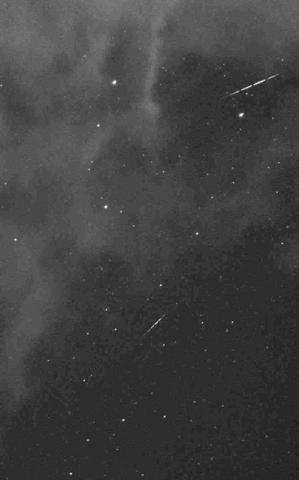- This topic has 6 replies, 3 voices, and was last updated 6 years, 4 months ago by
 Bill Ward.
Bill Ward.
-
AuthorPosts
-
4 August 2019 at 5:06 pm #574372
 Bill WardParticipant
Bill WardParticipantHi,
Having picked up a couple of cheap PC’s from an online store I set them up to run the two ZWO cameras I have.
The weather here has been warm and very humid for weeks now, that has meant almost continuous cloud cover! :-((
I had a short break in the clouds the other night which gave me the opportunity to test out the system. Turns out the cloud did return to haunt me but there were a few clear spells. Still not fully dark at my latitude but I was pleased with the results.
Picked up these two small sporadics and the cameras were getting down to ~ mag +9 (stellar) in the original frame with the 25mm f1.3 lenses.

This is around 1/3 of the full frame (rest was cloudy…) Brightest stars are alpha, beta and gam Cas.
Next job is to get some gratings fitted but looking at the long range forecast I’m not too hopeful for the Perseids, just as well I’m an optimist! 😉
Cheers,
Bill.
Attachments:
5 August 2019 at 8:08 pm #581230 Jeremy ShearsParticipant
Jeremy ShearsParticipantVery interesting results, Bill. Certainly an impressively faint detection limit.
I realise that you are mainly doing this for spectroscopy, but are you able to analyse the videos by UFO Analyser?
I hope you have some clear skies for the Perseids!
6 August 2019 at 8:43 pm #581232 Bill WardParticipant
Bill WardParticipantHi,
Thanks, with a bit of processing the ZWO174’s are decent performers. However your question is a VERY good one.
The issue is with the drivers. The response I’ve had from some of my Japanese friends is that they are surprised I could get it to work with UFOHD at all! I’m no expert in this field but from what I gather it is to do with the way UFO uses Directshow.
ZWO have continuously updated their camera drivers so something has changed to get it to work. Another issue seems to be the way the USB works. No matter what I do I cannot get the USB3 connection to work without dropped frames and crashing regularly and I can’t set the frame rate. But, and it seems odd to me, if I use an USB2 connection it works absolutely fine but you’re stuck with whatever the pc can crunch through. The global shutter places a high demand on the computer as it’s a lot of pixels to shunt around.
In my setup the native camera driver is running at 17.1fps with 50ms exposures on USB2 (3.3GHz quad cores) BUT UFOHD thinks it’s seeing 25fps… For detection, as you say, it is indeed fine when it’s just the spectrum your after but I think this may affect the velocity determinations and thus everything else downstream orbitwise.
So I would say probably not, but I’m not really sure how it’s actually working and I’ve never tried it so I can’t say for sure…
Cheers,
Bill.
7 August 2019 at 10:48 am #581233 Alex PrattParticipant
Alex PrattParticipantHi Bill,
I’m looking forward to seeing your hi-res meteor spectra with your new setup.
UFO Analyser should be able to extract astrometry and radiant data from your HD-quality videos but I don’t know how reliable the velocity measurements would be if the frame rate is variable.
A standard definition meteor video camera such as the Mintron or Watec has an internal clock that pumps out 25 PAL frames/second (50 fields/second) at a very reliable frame rate. Most old legacy PCs can cope with this bandwidth and are ideal for running UFO Capture.
When using a webcam or other imaging camera – especially at higher resolutions than PAL 720×576 – the PC has to be able to handle the data steam from the camera, which might not have a reliable and fixed transfer rate and the files can be big.
For HD-quality work SonotaCo recommend DSLR cameras that can deliver HD 1920×1080 video streams at fixed rates of 50 or 60 frames/second. This requires a beefy PC to cope with the demands on its data bandwidth and storage capacity. The cameras can overheat if they are left running for several hours.
All this is relevant for meteor velocity work, but isn’t important for your quality spectra.
Clear skies,
Alex.
7 August 2019 at 1:10 pm #581234 Bill WardParticipant
Bill WardParticipantHi,
I cut out some disc’s of plastic grating film and mounted them in little cardboard holders last night. So the system is now good to go. I’m hoping the weather will co-operate so I can get at least one spectrum (of anything…!).
I received an email from Derek with his first spectrum. Taken through this grating film and looking at his results, as with mine, either the meteor was very “blue” or the grating film has indeed better performance in the blue compared to the glass gratings I have used previously.
We’ll see…
cheers,
Bill.
7 August 2019 at 1:47 pm #581235 Alex PrattParticipant
Alex PrattParticipantHi Bill,
Fingers crossed that you get some spectra this month. As per usual, let me know and I’ll check my N camera for any matching events.
Clear skies,
Alex.
7 August 2019 at 3:57 pm #581237 Bill WardParticipant
Bill WardParticipantHi,
Will do, I’m planning on positioning the cameras where we’ve had detection’s before. Even with the bigger chip, using the 25mm lenses gives a slightly smaller FOV than the 12mm’s on the WATEC’s. I’ve got some 12.5mm lenses that will fully illuminate the ZWO chip but there is a magnitude penalty. I might try one of each, as the lenses use the same hood thread sizes so the gratings are effectively interchangeable.
Positive thought…. it WILL be clear on Monday night!
cheers,
Bill.
-
AuthorPosts
- You must be logged in to reply to this topic.
